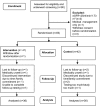Effects of exercise and lifestyle intervention on cardiovascular function in CKD
- PMID: 23970136
- PMCID: PMC3805077
- DOI: 10.2215/CJN.10141012
Effects of exercise and lifestyle intervention on cardiovascular function in CKD
Abstract
Background and objectives: CKD is associated with poor cardiorespiratory fitness (CRF). This predefined substudy determined the effect of exercise training and lifestyle intervention on CRF and explored the effect on cardiovascular risk factors and cardiac and vascular function.
Design, setting, participants, & measurements: Between February 2008 and March 2010, 90 patients with stage 3-4 CKD were screened with an exercise stress echocardiogram before enrollment. Patients (n=83) were randomized to standard care (control) or lifestyle intervention. The lifestyle intervention included multidisciplinary care (CKD clinic), a lifestyle program, and aerobic and resistance exercise training for 12 months. CRF (peak Vo2), left ventricular function, arterial stiffness, anthropometric, and biochemical data were collected at baseline and 12 months.
Results: Ten percent of randomized patients had subclinical myocardial ischemia at screening and completed the study without incident. There was no baseline difference among 72 patients who completed follow-up (36 in the lifestyle intervention group and 36 in the control group). The intervention increased peak Vo2 (2.8±0.7 ml/kg per minute versus -0.3±0.9 ml/kg per minute; P=0.004). There was small weight loss (-1.8±4.2 kg versus 0.7±3.7 kg; P=0.02) but no change in BP or lipids. Diastolic function improved (increased e' of 0.75±1.16 cm/s versus -0.47±1.0 cm/s; P=0.001) but systolic function was well preserved and did not change. The change in arterial elastance was attenuated (0.11±0.76 mmHg/ml versus 0.76±0.96 mmHg/ml; P=0.01). Δ peak Vo2 was associated with group allocation and improved body composition.
Conclusions: Exercise training and lifestyle intervention in patients with CKD produces improvements in CRF, body composition, and diastolic function.
Figures


References
-
- Sarnak MJ, Levey AS, Schoolwerth AC, Coresh J, Culleton B, Hamm LL, McCullough PA, Kasiske BL, Kelepouris E, Klag MJ, Parfrey P, Pfeffer M, Raij L, Spinosa DJ, Wilson PW, American Heart Association Councils on Kidney in Cardiovascular Disease, High Blood Pressure Research, Clinical Cardiology, and Epidemiology and Prevention : Kidney disease as a risk factor for development of cardiovascular disease: A statement from the American Heart Association Councils on Kidney in Cardiovascular Disease, High Blood Pressure Research, Clinical Cardiology, and Epidemiology and Prevention. Circulation 108: 2154–2169, 2003 - PubMed
-
- McCullough PA, Sandberg KR, Borzak S, Hudson MP, Garg M, Manley HJ: Benefits of aspirin and beta-blockade after myocardial infarction in patients with chronic kidney disease. Am Heart J 144: 226–232, 2002 - PubMed
-
- Padilla J, Krasnoff J, Da Silva M, Hsu CY, Frassetto L, Johansen KL, Painter P: Physical functioning in patients with chronic kidney disease. J Nephrol 21: 550–559, 2008 - PubMed
-
- Donnelly JE, Blair SN, Jakicic JM, Manore MM, Rankin JW, Smith BK, American College of Sports Medicine : American College of Sports Medicine Position Stand. Appropriate physical activity intervention strategies for weight loss and prevention of weight regain for adults. Med Sci Sports Exerc 41: 459–471, 2009 - PubMed
Publication types
MeSH terms
Substances
LinkOut - more resources
Full Text Sources
Other Literature Sources
Medical

